|
FAQs about Caryophyllid Coral Disease, Pests,
Predation 9
Related Articles:
Coral Pests and
Disease; pests, predators, diseases and conditions by Sara
Mavinkurve, Caryophyllid
Corals, Elegance Coral,
FAQs on Euphylliid Disease:
Caryophyllid Disease 1, Caryophyllid Disease 2, Caryophyllid Disease 3, Caryophyllid Disease 4, Caryophyllid Disease 5, Caryophyllid Disease 6, Caryophyllid Disease 7, Euphylliid Health 8,
Euphylliid Health 10, & Elegance Coral Disease/Pests,
FAQs on Euphylliid Disease by Category:
Diagnosing,
Environmental (Pollution/Poisoning, Lighting...),
Nutritional, Social (Allelopathy),
Trauma,
Pathogenic (Infectious, Parasitic, Viral)
Predatory/Pest, Treatments
FAQs on Stony Coral Disease by Category: Diagnosing,
Environmental (Pollution/Poisoning, Lighting...),
Nutritional, Social (Allelopathy),
Trauma,
Pathogenic (Infectious, Parasitic, Viral)
Predatory/Pest,
Treatments
Caryophylliids 1, Caryophylliids 2, Caryophylliids 3, Caryophylliids 4, Caryophyllid ID, Caryophyllid Compatibility, Caryophyllid Systems, Caryophyllid Selection, Caryophyllid Behavior, Caryophyllid Feeding, Caryophyllid Propagation/Reproduction,
Stony/True Coral, Coral System Set-Up, Coral System Lighting, Stony Coral Identification, Stony Coral Selection, Coral Placement, Foods/Feeding/Nutrition, Disease/Health, Propagation, Growing Reef Corals, Stony Coral Behavior,
|
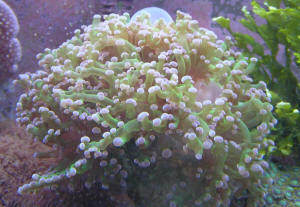
|
|
Shrinking Hammer Coral/Euphyllia Compatibility
7/16/10
Dear Crew,
<Joe>
Thanks so much for your dedication!
<You're welcome.>
Thanks to you, my reef tank is thriving, minus one specimen: a
hammer coral. First of all, here is the tank information.
I've tried to include as much relevant data as possible for
an accurate diagnosis.
54 Gallon Corner Reef
Rena Xp3 Canister 350 gph (sump coming soon)
Bak-Pak Skimmer
150 Watt 14K HQI
65 Watt PC 10K/6700K
2 Maxi-jet's w/Hydor Flo
RO water, pre-buffered
Tropic Marine Salt
B-ionic daily
2 gallons changed twice weekly
SG 1.025
Temp 80-82.5 degrees F (running warm during the summer
months)
pH 8.4 (p.m. reading)
Ammonia 0
Nitrite 0
Nitrate 0 (although undoubtedly present in tank)
DKH 11
Calcium 340 (running unusually low)
Magnesium- Still need to buy the darn test kit!
Corals:
1 Torch
1 Hammer
1 Frogspawn
2 Bubble Corals
1 Candy Cane
1 Galaxy (isolated)
Green Star Polyps
Xenia
Button Polyp/Yellow Colony Polyp (very small colony)
Fish and Inverts:
Midas Blenny
Royal Gramma
6-Line Wrasse
Lawnmower Blenny (small)
Small feather duster
Skunk Cleaner Shrimp
Misc. snails and tiny hermits
The tank was set up as a FO for 3 years and as a reef since
January. The hammer was one of the first specimens and over the
past 3 months it has exhibited obvious signs of polyp shrinkage.
The attached photo was taken 1 month ago and the coral has
decreased in size by about 20% (coral appears on the left side in
photo).
I have never witnessed any tank inhabitants sampling any corals
and do not think that allelopathy is the cause (you may
disagree!). I also do not think that the low calcium level would
be the cause. My best guess would be an issue with too little or
too much light or water flow. The specimen is placed about 18
inches under the HQI bulb and is fed a mixture of Mysis, NLS
pellet, and various blended marine meat (although it does not
appear to eat much compared to my voracious bubble corals). In
addition, I've noticed that it, along with my Frogspawn
almost completely withdraw their polyps at night and do NOT
accept food unlike the other corals. I attempt to feed these two
during the day.
My apologies for the long email. I do know that you prefer to
have too much info. as opposed to too little. Again, thank you SO
much for your generosity.
You truly have helped thousands of hobbyists and we appreciate
everything that you do!
<Your Torch, Hammer, and Frogspawn Corals are all Euphyllia
species and are aggressive in terms of allelopathy. The Hammer
Coral, in my experience, is the most difficult of the three to
maintain with all three being moderately difficult. I believe the
Hammer Coral is likely losing the allelopathy war. I would move
the Hammer Coral 6 to 8 inches away from the other Euphyllia
species you have in your system. A note on magnesium....magnesium
is a
major element of sea water and should be maintained at
1200-1300ppm. Low magnesium levels hinders stony corals from
absorbing calcium to varying degrees depending on the actual
magnesium level in your system.
An example is if your calcium measures 400ppm and your magnesium
measures 650ppm, only 200ppm of calcium is actually available to
the corals. You may also want to read here and related
articles/FAQ's found in the header.
http://www.wetwebmedia.com/caryophyllids.htm>
Thank YOU!
<You're welcome. James (Salty Dog)>
Joe W.
|
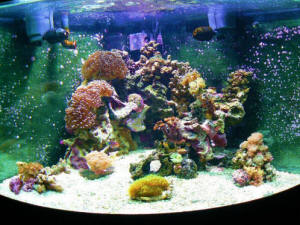 |
Torch Coral 5/31/2010
Hi gang, just back from Longboat Key Fla.
<Ahh! A few of us were t/here last year diving>
Had a great time and will post some pics later. Since I got back it
appears something has happened to my Torch Coral. It grew from 5 heads
to over 15 and was doing great. When I got back, 3 heads are dead and 3
or 4 are not expanding. The rest of the heads seem o.k. The only thing
I did different was to turn off the skimmer for the week I was gone.
Fish were fed every other day. There is a large Yellow Fin Damsel in
there and once in awhile he nips at it but nothing terrible. I
don't know if he would eat them?
<Might a little... if hungry... but sufficient to kill so much in
such a short period of time?>
or, if the water being "dirtier" had a negative effect. All
water parameters are good. The Frog Spawn is real good and all the
leathers are doing fine. Any ideas??
<Likely the Leathers duking it out with the Euphyllia... Use the
search tool on WWM w/ the term "compatibility" and read the
cached views...
Allelopathy is my best guess:
http://wetwebmedia.com/cnidcompppt.htm
Bob Fenner>
Dead Hammer Coral 5/31/2010
I had a breakdown in my tank and lost my 2 HUGE hammer corals, and 2
smaller frogspawn. Tank overheated up to 93 deg. anyway,
<Mmm, my gen. comment here... IF what one has is valuable,
personally or financially, I would NOT run resistant heaters w/o a
separate controller... See WWM re>
very upset about my loss but its been a few weeks, I thought it might
come back and after a couple days it got a film over the top that
looked like a fungus covering it. it eventually disappeared and now I
am transferring everything into a new aquarium setup. Can I keep the
skeletons?
<Oh yes>
It has a bad smell to it but has not seemed to affect my other
inhabitants.
<Mmm, you might want to remove, bleach... rinse... See here:
http://wetwebmedia.com/clnornart.htm
and the FAQs file above.
Bob Fenner>
|
Frogspawn Tissue Recession... reading
5/8/10
Hi Crew,
<Josh>
I just finished reading Anthony Calfo's Reef Invertebrates
book
<... I'm the co-author>
for the first time -- a fantastic resource! But, unfortunately, I
haven't made it to his Coral Propagation book yet, so I was
hoping to get some insight from you all on some trouble I'm
having with my branching frogspawn.
<... have you read...? Obviously not, as you too have not
complied w/ our requirement of limiting file sizes for
graphics...>
It's been living happily in my tank for about 3 months with
no trouble until about three weeks ago, when I noticed that one
polyp had lost a single "section" of tentacle, exposing
the corresponding section of the skeleton (septum?) underneath. I
suspected that it may be from too much flow in my SPS-dominated
tank.
<Doubtful>
I continued to monitor this, but did not notice any worsening of
the condition until today, when I discovered that another
tentacle had disappeared (not directly adjacent, but 2 septa(?)
over from the first missing tentacle. Additionally, I noticed
today that the polyp that lost the tentacles also appears to have
lost some of the tissue and baring a white skeleton along that
branch, extending across a good part of the whole colony. I
don't know how long that's been that way. I've also
noticed recently that, while the colony still does
"inflate" (extending polyps/tentacles) a fair amount,
the average inflation size has been less over the past couple
weeks or so. it gets bigger than shown in the pictures I've
attached. I haven't noticed any brown jelly or slime from the
coral.
I have seen a few brown flatworms crawling on the frogspawn, but
never more
than 5-6 at a time, and I've never seen any other flatworms
in the tank, so I haven't treated the tank to get rid of
them.
<Not likely flatworms>
As far as the rest of my tank goes, none of my other livestock
has exhibited
any similar problems. The rest of my corals are SPS (Staghorn
Acropora, millepora, Montipora digitata, Montipora capricornis,
etc.), and my fish are: 1x bluespotted Jawfish,
<Misplaced here... won't live well or long... See WWM re
Opistognathus rosenblatti>
1x ocellaris clownfish and 1x royal gramma.
There is also a peppermint shrimp (I've seen them eat
Euphyllias in the past!), cleaner shrimp, and bumblebee, Trochus,
Nerite and Nassarius snails. The tank is 39 gallons
(24x20x20" cube) with a 12 gallon sump with a small Chaeto
refugium/5" DSB. My tank is lit by a 150w radium 20k halide
supplemented by 2x24w ATI Blue Plus actinic T5HO bulbs (I should
note that I have replaced each of these bulbs within the last 3
weeks, including moving to the 20k radium from a 14k bulb, but I
did take steps to acclimate the
corals to the new lights over about a week). For flow, I have a
Vortech mp10 (set to 100% reef crest mode) and Tunze 6025
powerhead, with a Tunze 1073.020 return pump. My skimmer is a
Bubble Magus NAC3. There is approximately 40lb. of live sand and
60lb of live rock in the tank.
My specific gravity is 1.024, with a temperature between
80-80.5F.
Ammonia/nitrite are 0, and my nitrates/phosphates are
undetectable, but I do have a fair amount of hair algae, so I
suspect these parameters are not legitimately 0. My Ca is 420 and
my Alkalinity is 7 today (though it has swung between 6.5 and 8.5
over the past week -- I suspect this as a possible
issue here). I'm not sure what my Mg is, but based on the my
last test and subsequent dosing to correct it, I'd estimate
it is now between 1250 and 1350.
Is there anything I can do at this point? I'm usually not
someone who aggressively treats these sort of things, but based
on my research, I'm concerned that this may go downhill
quickly. My plan is to move it to a
lower-flow area of the tank. Is there anything else I should do?
I've attached some pictures.
Thanks in advance!
Joshua
<Oh yeah, read: http://wetwebmedia.com/cnidcompppt.htm
and http://wetwebmedia.com/carydisfaq2.htm
and the linked files above. You're welcome. Bob
Fenner>
|
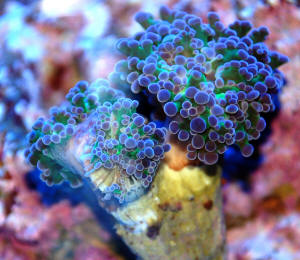 |
Re: Frogspawn Tissue Recession
5/8/10
Dr. Fenner,
<Hey Josh! Just Bob please. I have no doctorate>
Apologies are owed on two fronts -- first, my apologies for the
large files. I had read the rules the last time I had submitted a
question, but admittedly, it had been some time, and I should have
reviewed them again before submitting this one. Second, I knew that
you were the co-author of the Reef Invertebrates book -- in fact,
it was reading the Conscientious Marine Aquarist book that led me
to read the Reef Invertebrates book in the first place. I think I
was just getting crossed-up based on the fact that Mr. Calfo is the
author of the Coral Propagation book. In any event, I just wanted
to apologize for my oversights.
<Ah, no worries. Am (and getting to be more so!) persnickety out
here in Egypt... the Net is slow and maddeningly intermittent...
Spent a couple of hours in none less than McDonald's on their
pay for "McNet" this afternoon, skipping a day of diving
et al... trying to catch up... Am having to forego a few hours of
sleep every AM...>
Regarding my frogspawn issue, first, there does not appear to have
been any sort of coral competition that has led to this tissue
recession, so far as I am able to observe.
<Ahh, these events can be insidious in their moda>
I'm skimming and running Seachem matrix activated carbon.
Skimmer production has been steady, not unusual or elevated. The
frogspawn is well away from any other corals. It is situated at the
bottom of the tank, away from the direct light from the 20k halide
bulb.
Regarding the flow, I positioned it so that it was far away from
direct flow from my powerheads, but it still seems to get strong
currents around it, frequently resulting in tentacles "bent
over" the side of its skeleton (such that it looks like the
tentacles may be in danger of being sawed off from the polyp by the
sharp septum).
<Good points, input. I would definitely "aim" the
current away or alternatively, more this Euphyllia to a less motive
area>
As far as the Caryophyllid FAQs on disease/pest/predation, I did
read through many of them yesterday before sending my email to you.
It was reading those that indicated to me that it could be an
urgent situation.
Unfortunately, my reading of the FAQs did not indicate to me
whether this tissue recession was the type and extent that would
require a dip, or whether it might just be the result of the
fluctuations in alkalinity or predation (e.g. peppermint shrimp,
bumblebee snail), which would more easily be resolved by
maintaining stable water parameters/low stress and allowing it to
recover. Many of the FAQs with tissue recession similar to mine
seem
to be handling issues, which I don't suspect here based on the
length of time I've had it.
<I see... and yes to their being a few categories of probable
cause here>
On a side note, re: my Opistognathus rosenblatti, I had actually
read your article on them when you sent it to me several months
ago.
<Oh!>
It was very helpful. The fish been "king of the sandbox"
in my tank for about 6 months
now. Over the winter, the tank was staying at 78.5F pretty
consistently, so I wasn't as concerned; however, now that the
weather has begun to warm up, the tank is averaging up around
80-80.5F. I've just recently taken steps to try and cool the
aquarium with larger/more efficient fans/better ventilation. If
that doesn't work, I will be purchasing a chiller.
<Ah, good>
Thanks again for any advise you can offer, Dr. Fenner.
Joshua
<Thank you for your thoughtful, respectful response.
BobF> |
|
hammer coral in trouble, need to ID the culprit. The
aquarist 3/22/10
Hi!
<Hello Alex>
I am looking for advice on my hammer coral. I got him about 2
weeks ago.
Seems like he had a little shipping damage to one of the
heads.
<Mmm, more than a little>
He seems to be pulling away from the area little by little. Now
overnight I found this on him.
<This?>
I have attached the photo so you can see, its the head on the
left. At first it looked like a brownish looking gel on the
skeleton, but in matter of a few hours it is now covered with
some white powder. I have no idea what it is. How should I
proceed from here? The other two heads seem to be in good shape.
Should I try feeding him shrimp directly to his mouth? I am
afraid of stressing him out at this point so I want to proceed
with caution.
Thx!
Al
<Umm, this specimen/colony is outright dying... You've
provided no useful information re the system, lighting,
filtration, water quality, other species present,
foods/feeding... Let's have you read a bit... Here:
http://wetwebmedia.com/carydisf7.htm
and the linked files above... where you will likely answer your
own questions. Do write back w/ data if you'd like a more
substantive response.
Bob Fenner>
|
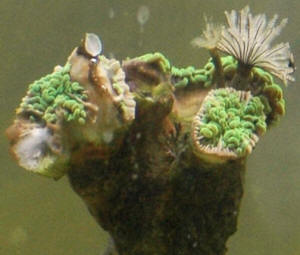 |
Re: 05/02/10 Euphyllia hlth. mostly --
02/14/10
<Hello Ryan>
Let me know if this photo helps.
<Mmmm, looks dead to dying to me>
Nitrate>50 PPM
<This is 5 - 10 times too high. The major concern here>
Nitrite>.1PPM
<This should be zero. Have you double tested this
result?>
Phosphates 0
<Some is required>
Salinity 1.21
<1.021? This is too low. Should be 1.025 - 1.026>
Temp 74.5 F
<Would raise this as well to 78-80>
Canister filter with GFO
<A probable source of nitrates if not cleaned twice a week, and
the GFO is not something I would be running here>
Phosban
<As well?>
Carbon
V\R
<I'm not sure what this is... maybe it is too early in the
morning for me....>
Ryan
<Yes, Ryan, this does help a lot. As noted above your problems
are water quality and chemistry. Do be aware, that this is a
calcifying organism and requires that calcium, alkalinity and
magnesium are correct as well as the
others noted above. Please read here:
http://www.wetwebmedia.com/watrqualmar.htm.
Simon> |
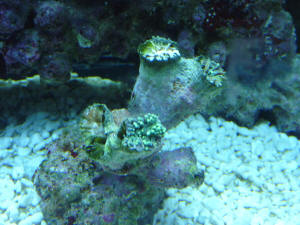 |
05/02/10 Euphyllia Compatability mostly
Hi,
<Hello Ryan>
I have a questions about my Euphyllia glabrescens "Torch
Coral".
<Ok>
For the last 6 months it looked fine, clown fish even stated using it
as a host. Lately its tentacles have become very short and are simply
staying retracted. No other problems with any of my corals. I just
can't seem to figure out what the problem is.
<Mmm, Clowns can irritate corals such as this if their advances are
too 'enthusiastic'>
Water chemistry has been a little off, <? This> but nothing
major.
<Any numbers here? After a statement like this surely you expected
me to ask such a question?>
I have over 15 other different corals both leather, LPS, anemones
etc.
<This too....>
None of which are having any problems. I simply cannot figure out what
is wrong.
<Reading: http://www.wetwebmedia.com/cnidcompfaqs.htm >
Please help if you would like photos I can send. Thanks for your help
in advance.
<You have at least three possible causes that I have identified
here, could be one or a combination of these...>
Ryan Irvine
<Simon>
|
Bubble coral detaching from skeleton
1/02/10
Hello
<Hi there>
I need some assistance with my Bubble Coral, I hope you can offer
some advice :)
As you can see from the attached photo it is almost entirely off
its skeleton.
<Yes... trouble>
I have only had the coral 3 days. The shop wrapped it in wet
newspaper for transport
<!?>
and I suspect it was severely damaged in the process.
<... it was shipped, moved w/o water? Why?>
I have since done a lot of searching and now know the tips about
ensuring they handle the coral only from the base, and give the
coral a small shake to deflate the bubbles before transport
etc
<Shaking gently is fine>
My question is, Will my bubble coral recover? and is there
anything I can do to assist?
<I doubt it and yes>
The coral is inflating/deflating albeit in its elongated position
and is feeding - I have been giving it a pea sized piece of raw
scallop flesh at night
My water parameters are - Ammonia 0, Nitrite 0, Nitrate 0,
Phosphate 0, Calcium 440, SG 24, PH 8.1, KH 161 (or I think about
9 DKH?
<Yes>
unsure of the conversion)
<Easy enough to do the division...>
I hope you can offer some advice - and that the news will be
good.
Kelly
<Read here: http://wetwebmedia.com/caryophyllids.htm
the linked FAQs files above, particularly Health/Disease,
Systems, Feeding...
Bob Fenner>
|
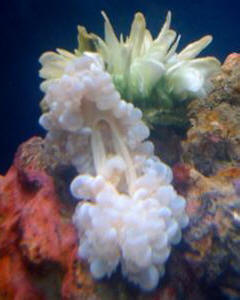 |
|
Question about really sick Euphyllia
12/2/09
Greetings,
<And you, Salud!>
I have a Euphyllia parancora with 12 heads that looks just like
in the photo.
<I take it this is not your image then and won't
post>
I know it's not what people expect to see when they hear
Euphyllia.
I'm not going to ask whats wrong as I'm quite sure I know
it was my own stupidity that cased the nitrogen cycle to crash
and restart.
<!?>
This was almost 4 weeks ago.
Once I understood what was wrong I did daily water changes of
about 20% of the water volume each day for 2 weeks and it has
saved everything in my aquarium except a few Montiporas and these
Euphyllias. Today I don't add anything except water and salt
and the water quality at the moment is:
temp = 26 C
salinity = 1.024
pH = 8.0
NO2 = 0.05
KH = 7.8
NO3 = 0
NH3/NH4+ = 0
MG = 1400
Ca = 450
The Euphyllia parancora doesn't show any tissue damage, no
brown jelly and the skeleton is not visible through the polyp
anywhere. It has just lost it's color and refuses to expand.
One week ago most of the heads had small bumps where the mouth is
and if anything moved the corals they opened the mouth and let
out some white "smoke"
<Mmm>
I'm asking for an educated guess of what happened in the
Euphyllia when the nitrogen cycle crashed?
My guess is the symbiotic algae died while the coral itself
survived.
<Could well be>
But I might as well be miles of in my guess. Also do you think it
has a chance of surviving or is it starving to death at the
moment?
<Can be saved... What are you feeding? Have you dosed an
iodide/ate product? I would>
Best regards,
Tony
<Please read here: http://wetwebmedia.com/carydisfaqs.htm
and the linked files above. Bob Fenner>
SV: Question about really sick Euphyllia
12/2/09
Thanks for the fast answer. The Euphyllias used to pick up a few
mysis or Artemia when I gave it to my fishes but as it is now
nothing will stick to the deflated tentacles and the mouth is
really hard closed.
<Please read the Caryophylliid Feeding FAQs files; where you
were referred last>
I haven't dosed any iodide as I thought the salt and the
frequent water changes would give me enough (I use Red sea coral
pro salt) but will start dosing tomorrow.
<Good>
One thing I noticed since yesterday is that a few of the smallest
polyps seems to have inflated the tentacles a little. A few
millimeters closest to the mouth is now 2-3 mm thick instead of 1
mm as on the larger polyps.
<A good sign. These Scleractinians can recover having just a
bit of live tissue... BobF>
Best regards,
Tony
SV: Question about really sick Euphyllia
I just noticed you didn't post the image online. The photo is
taken by me and is a little part of my Euphyllia so if you think
there is any educational value in showing the image the please
feel free to use the image as much as needed.
<Oh! Sorry for the misunderstanding. Will append. The way the
wording occurred to me, I considered that the image had been
lifted from elsewhere. Thank you for clearing this up.
BobF>
Best regards,
Tony
|
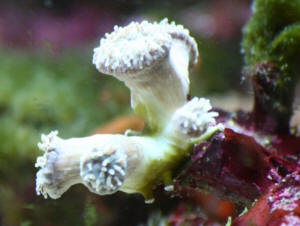 |
|
What is this bubble on my frogspawn?
10/11/09
My Frogspawn seems to be healthy however it has developed a
rather large bubble on it. I have researched quite a bit however
I am not able to pin point the problem, if it is indeed a
problem.
<Mmm, please do send image/s along with such questions>
My local reef stores just keep suggesting water changes, implying
my chemistry is off or bad husbandry. My water chemistry as well
as filtration is all proper for a healthy marine aquarium. Also
of all the photos posted online, I have yet to see anything like
it. By the way I have a 75 gal.
with power compact & T5 lighting.
Kayla Bowden
<Expansions of tissue are not uncommon in
Euphylliids/Caryophylliids. I would not be concerned if all else
were/is fine with your system/livestock. Bob Fenner>
No worries here. RMF
Re: What is this bubble on my frogspawn?
10/11/09
Did you receive the photos of the bubble? I wasn't sure if
they went through or not. If you saw the pics, and still stand by
your response then what a relief.
<Yes>
I am glad there's nothing wrong with it!!! I thought it may
have been reproducing?? Thanks for the speedy response!!!
Kayla Bowden
<Please see WWM re the family, Behavior, Health...
BobF>
|
 |
Frogspawn coral problems 8/24/09
Hi
<Hello Jessy here>
Just wanted to ask a question regarding my frogspawn coral.
I've had problems with ammonia from what could have been caused by
a bad batch of salt - everything seemed to cope except the frogspawn,
which was very sensitive.
It stopped eating shortly afterward, and although I changed brands of
salt, the ammonia dropped to zero straight after, it doesn't seem
to be able to recover properly. Still not eating and polyps on some of
the branches often shrink up or withdraw. Can this coral survive on
photosynthesis alone for long periods of time?
<This coral does not need to be fed at all. It can live very happily
without being fed directly, I've had frogspawn go from 3 heads to
50+ heads and never fed it once.>
I have noticed that although I have had no recession some of the
tentacles shrink up, turn bright green and start breaking off. I am
worried this could be harmful to other fish and corals should they eat
them by mistake.
<This is not harmful, its parts that are damaged from whatever water
quality issues you've been having most likely. Just make sure if
you see one landing on a surrounding coral you take a turkey baster and
blow it off. They will sting other corals.>
Also there is very high flow in the tank but my bubble coral is a very
happy coral -is this a factor in its recovery? All other corals in this
mixed tank doing very well - no problems at all.
<High flow shouldn't be a big issue if your bubble coral is
happy in the same tank.>
Water param.s are:
PH-8.3
Nitrite-0
Nitrates-0
Ammonia-0
Phosphate-0
Calcium-420
KH-8
What can I do as I'm very worried about this coral?
<Looks like your parameters are okay. Just allow it some time to
recover and adjust to the change of salt. Don't try and force feed
it. It will be fine if your tank is healthy>
Also would like to know your impressions of Tropic Marine (thinking of
using) and Tetra Marine (recently switched to) and in your mind after
Seachem (not available here) what would you say is your preferred
salt?
<I've heard great things about Tropic Marine although I've
never used it myself. I've never used Tetra Marine either. I've
never heard any problems with Instant Ocean or Red Sea Coral Pro
salt.>
Thank you so much - I value your advice tremendously
<Regards, Jessy>
Many thanks
Anonymous
<If you do write in again, please take better care with grammar and
sentence structure. I had to fix a lot of errors to make it
presentable.>
|
|

